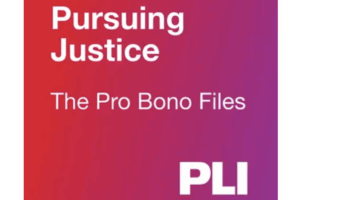 I’m a big advocate of the power of ESI to help get to the truth of the matter faster. No shock there. But what I am seeing more and more (and more) of is what I have come to call the eDiscovery Disconnect.
I’m a big advocate of the power of ESI to help get to the truth of the matter faster. No shock there. But what I am seeing more and more (and more) of is what I have come to call the eDiscovery Disconnect.
You know what I mean — it’s the look in the attorney’s eyes when you start talking about eDiscovery. The light goes out. Because as lawyers, we want to dive into the facts, strategize, and do what we do. And most don’t know a lot about data and technology, so the very thought of it turns us off.
Or, as in-house counsel and even the GC, you only see dollar signs when you think about eDiscovery. That’s justified in many cases. But I think that you spend too much because your lawyers aren’t IN the data or the eDiscovery plan the way that they should be.

Pursuing The Pro Bono Story: A Conversation With Alicia Aiken
This Pro Bono Week, get inspired to give back with PLI’s Pursuing Justice: The Pro Bono Files, a one-of-a-kind podcast hosted by Alicia Aiken.
Because the cost is high and the interest factor is low in eDiscovery, much of the data work gets pushed down to litigation support or outsourced to the vendor and there is no substantive communication with the lawyers themselves. Substantive discussions involve case strategy, identifying key issues, focusing on custodians and creating a case chronology. There are hundreds of decisions to be made before you start reviewing data. Instead, I see first pass review done as a necessary evil and expense, and we don’t end up too much further down the line after spending thousands and sometimes millions of dollars. Those decisions — to be made by an attorney — are never made.
A gap exists between the work being done on the data and the legal strategy for a matter. That, my friends, is the eDiscovery Disconnect. We added a little “e” to discovery and suddenly we are leaving the legal out of discovery.
Here’s the rub — the litigation support folks, and yes, even the world’s most amazing project manager — have no idea what the lawyers want to focus on, how the lawyers want to be able to spin a story or how they want to present ESI as evidence at a proceeding. That’s the lawyer’s job to think about and strategize. How you handle the data up front impacts every area of your case, but you’re asking a non-lawyer to do it. You’re not asking them to make those decisions for you — they can’t do that — instead, those decisions just aren’t being made.
Ask yourself these questions:

How Innovative Legal Teams Are Turning AI From Promise To Practice
In recent years, AI has moved beyond speculation in the legal industry. What used to be hypothetical is now very real.
- Does how you present evidence differ if you are in trial vs. mediation vs. arbitration?
- Do you need to present ESI in a way that the tribunal can know immediately the message you are trying to portray?
- Do you want a notebook full of every single email sent or received by your witness to ask them about? Or do you want the important stuff that focuses on just the issues that matter?
- Do you need to have visuals or present ESI in a way at depositions that allow you to ask the most effective questions of a witness? Taken one step further, have you ever asked the ONE question at a deposition that ends the case? (I have. I was so stunned I had to stop and figure out what to do next. Without grinning like a chesire cat.)
If you answered yes to any of those questions, then you need to be in the game early on when deciding who to talk to, what sources to collect from and how, how the data will play out, who talked to who, where the dirt is, and all the other small details that feed into the big picture of your case. They are in the data.
My point is this — the data folks know the data and how to use it. They know the tools and how to use them to manipulate data. But they don’t know how the lawyers want it unless they know what you need. Here’s one example of how the data presented to lawyers really matters:
A lawyer needs a cell phone imaged to show deleted communications between two parties with pictures and captions to those pictures. He’s not used to ESI and needs the results to be an exhibit to his motion papers. Does the report that comes from the standard imaging tool give him what he needs? No. It’s an excel spreadsheet that separates the pictures from the text message. Unless he can have someone create a representation of what’s on the report that portrays that message, the potential wow factor of his evidence is lost. It doesn’t look in a report like it looks on an iPhone screen. A judge/arbitrator/mediator knows what an iPhone looks like and those pictures with captions could resolve the case. But the report is foreign and packs no punch. If the lawyer knew ahead of time what the report will look like, or that it won’t meet his needs, he can ask for something else. Most times he won’t know TO ask for something else. And the vendor imaging the phone won’t ask the question because evidence presentation is NOT WHAT THEY DO.
See what I mean? The end game has to come first, and the decisions about data flow from the end game. The data folks don’t know the end game. (Hint: they can help if you tell them.)
RelativityFest last month hosted 1934 people. This was, as far as I know, the biggest legal technology user conference out there. Guess how many of those 1934 attendees were attorneys? 148. And that included the speakers, which makes up a good part of that 148. Leaving the speakers in, that’s 7.6%. Now some of you are thinking — Kelly, it’s a user’s conference and the lit support people are the users. EXACTLY. That’s the problem. The lit support people are the only users. The data is in the platform and the attorneys are not. Relativity is designing some pretty cool features for attorneys — they just have to get the attorneys to use the tool.
And, as an aside, there were 135 marketing and sales professionals — and only 13 more attorneys. eDiscovery Disconnect.
As an associate, I worked with one of the best at Litigation Risk Analysis — he taught and used decision trees to help assess the value of a matter and we worked them throughout the case to constantly help the client assess where we were in value and how to decide next steps. Those decision trees changed as the facts changed and expanded through discovery. Without knowing the facts through the data, your ability to give your client the advice they need on litigation risk is lost. That’s your job. Do your job.
 Kelly Twigger gave up the golden handcuffs of her Biglaw partnership to start ESI Attorneys, an eDiscovery and information law Firm, in 2009. She is passionate about teaching lawyers and legal professionals how to think about and use ESI to win, and does so regularly for her clients. The Wisconsin State Bar named Kelly a Legal Innovator in 2014 for her development of eDiscovery Assistant— an online research and eDiscovery playbook for lawyers and legal professionals. When she’s not thinking, writing or talking about ESI, Kelly is wandering in the mountains of Colorado, or watching Kentucky basketball. You can reach her by email at [email protected] or on Twitter: @kellytwigger.
Kelly Twigger gave up the golden handcuffs of her Biglaw partnership to start ESI Attorneys, an eDiscovery and information law Firm, in 2009. She is passionate about teaching lawyers and legal professionals how to think about and use ESI to win, and does so regularly for her clients. The Wisconsin State Bar named Kelly a Legal Innovator in 2014 for her development of eDiscovery Assistant— an online research and eDiscovery playbook for lawyers and legal professionals. When she’s not thinking, writing or talking about ESI, Kelly is wandering in the mountains of Colorado, or watching Kentucky basketball. You can reach her by email at [email protected] or on Twitter: @kellytwigger.